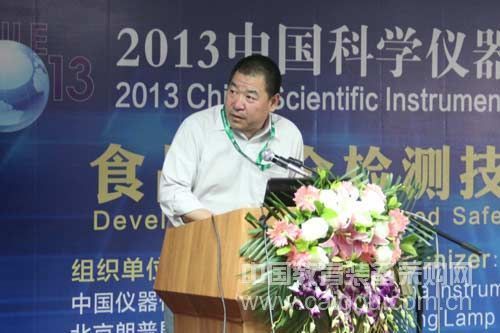Yang Kai: Laboratory electrophoresis equipment service food safety identification testing
On May 15, 2013, the 11th China International Scientific Instrument and Laboratory Equipment Exhibition (CISILE) was held as scheduled at the China International Exhibition Center. At the exhibition, the China Scientific Instruments and Laboratory Equipment Summit Forum opened simultaneously. Among them, food safety detection technology is a hot spot in society and people's livelihood. The special forum in this direction has attracted many audiences.
Professor Yang Kai from the Key Laboratory of Beijing Agricultural College gave a report on the application of laboratory electrophoresis technology in the field of food safety.

Professor Yang Kai, Key Laboratory of Beijing Agricultural College
Electrophoresis technology: The charged particles move toward the electrode opposite to their electrical properties under the action of an electric field. The technology that uses charged particles to move at different speeds in the electric field to achieve separation is called electrophoresis technology. Biological individual differences.
Features: Electrophoresis technology has the advantages of fast, high accuracy and good repeatability in food safety inspection. It is widely used in food production inspection, quality control and food safety.
Screening of food protein allergens by two-phase electrophoresis
This research method is one of the most commonly used and most mature techniques in proteomics research, and has been widely used in the identification of species genetic variation and protein amino acid identification. The application of this technology has many advantages in the screening and detection of food allergens, such as strong resolution, large amount of information, easy handling, good reproducibility, and computer analysis and processing.
Choosing 2-DE detection technology for the detection of food protein allergens can achieve fast, convenient and accurate early prediction, and avoid the ingestion of certain food allergens by sensitive groups and cause group allergic reactions.
Identification of Food Materials by Polyacrylamide Gel Electrophoresis
In terms of food processing, the quality control and authenticity of food raw materials have always troubled the processing enterprises. The electrophoresis technology is used to test the protein of the seeds (seeds) or seedlings of the varieties to be inspected. According to the differences in protein electrophoresis bands, Compare with the standard band of the variety to identify the authenticity and seed purity of the variety. The polyacrylamide electrophoresis method using isozyme electrophoresis and seed protein electrophoresis has been widely used in variety identification and plant food material purity analysis research methods.
Application of Denaturing Gradient Gel Electrophoresis (DGGE) in Food Microbiology Research
85% -99% of microorganisms in the natural environment are still uncultivable so far. The traditional research method of microbes in the industrial fermentation industry is to isolate and purely cultivate microorganisms in fermented food, count them, and then use taxonomy and phylogenetic methods To identify the dominant bacteria. The microbial flora growing in many fermented foods is still unknown or cannot be cultured purely. In order to further understand the microbial status of fermented foods, control and evaluation of the production process and product quality of fermented foods requires understanding of the microbial population diversity, community structure changes, and physiologically active microbial strains at various times during the fermentation process, using PCR-DGGE technology , You can study the composition of bacteria and fungi in fermented food, identify functional microorganisms and pathogenic bacteria, evaluate and control food quality, and identify functional microorganisms and pathogenic bacteria.
Identification of food-borne pathogenic bacteria by pulse field electrophoresis (PFGE)
Generally speaking, the analysis process of food-borne microbial food poisoning is to separate food-borne microbes from the kitchen environment (including kitchen staff, tableware, dishcloths, etc.), and then to remove vomit, stool or anal swabs from patients with food poisoning Isolate food-derived microorganisms during the separation, extract the total DNA extracted from the isolated microorganisms suspected of causing food poisoning, digest the total DNA with Xbal, and perform molecular typing by pulse field gel electrophoresis (PFGE) method, and use statistical software to analyze the PFGE typing pattern Carry out electronic data analysis and draw a cluster analysis chart. When the molecular typing is basically the same, the path and type of biological contamination of the food source can be determined. PFGE has the characteristics of strong typing power and high repeatability, and can intuitively judge the isolated bacteria. PFGE can be used to identify the infectious source of the outbreak in time to effectively control the spread of the epidemic. PFGE can be used as an analysis technique to identify bacteria in the outbreak.
Using this detection method, China's local disease prevention and control center successfully, quickly and accurately analyzed many food poisonings caused by bacteria such as Salmonella typhimurium, Proteus mirabilis, Campylobacter jejuni, etc. Tracking and tracing, and effective control of the source of infection.
Household Paper,Household Paper Towel,Household Tissue,Household Paper Napkin
BODA ENTERPRISE LIMITED , https://www.bodapaper.com